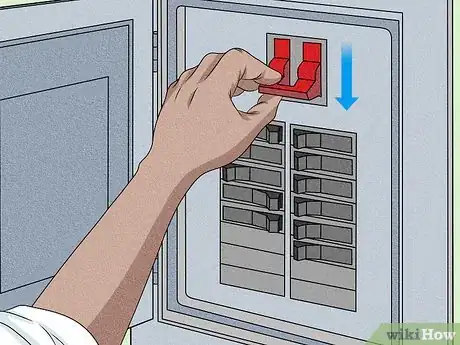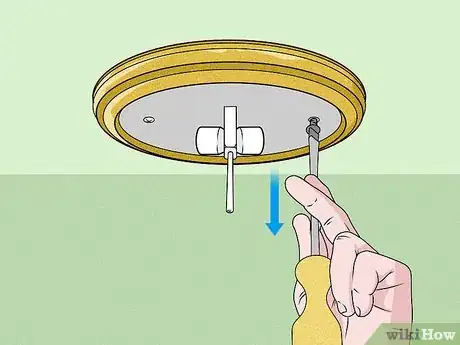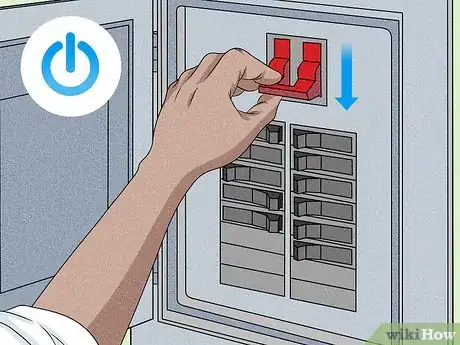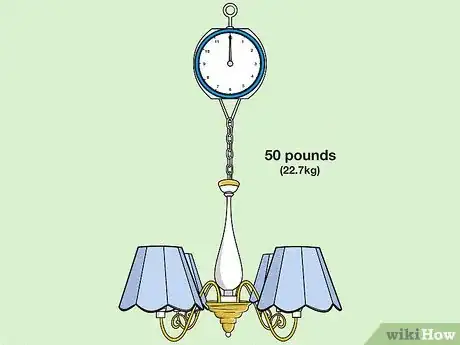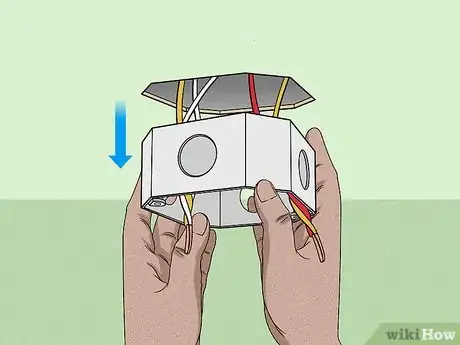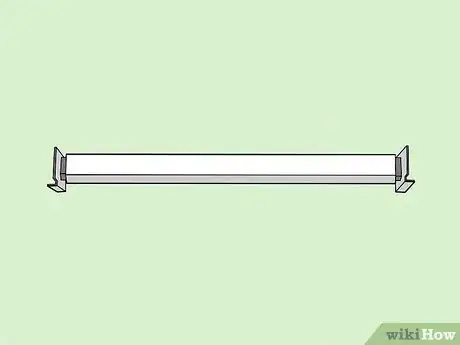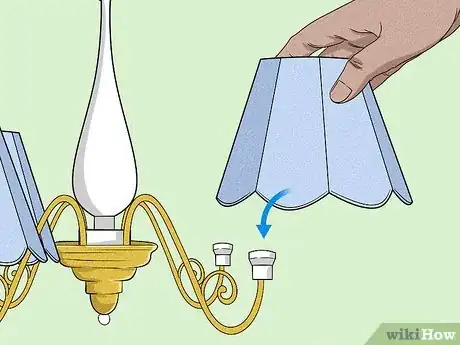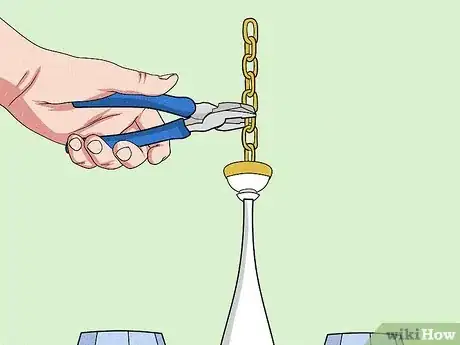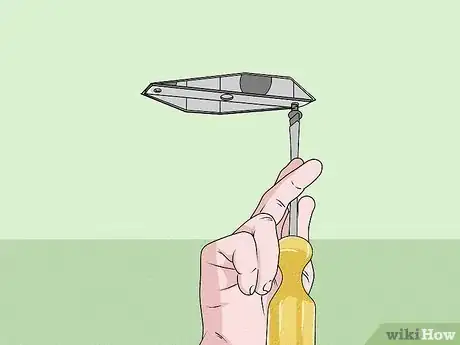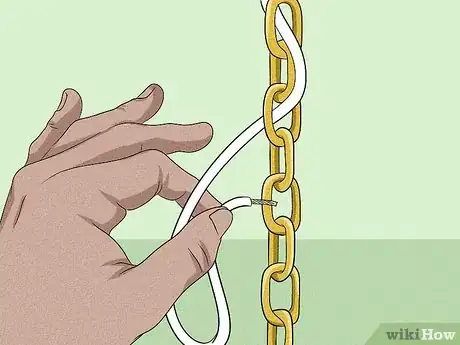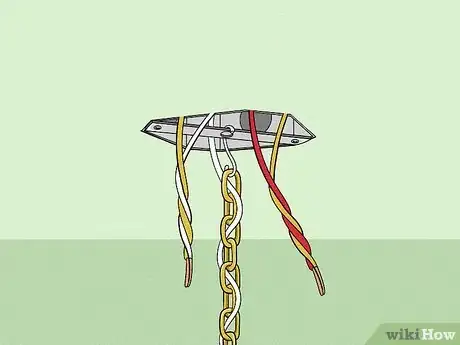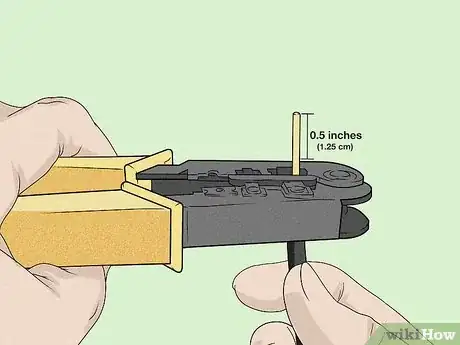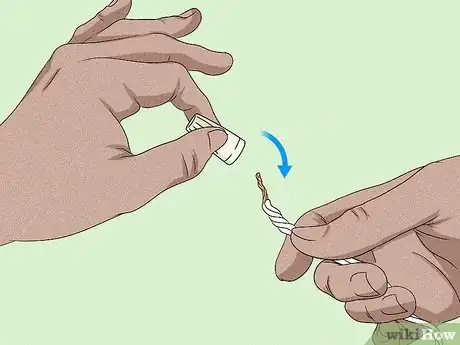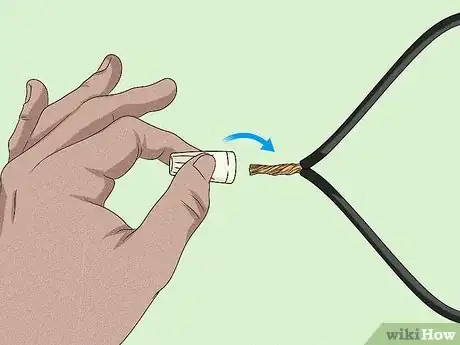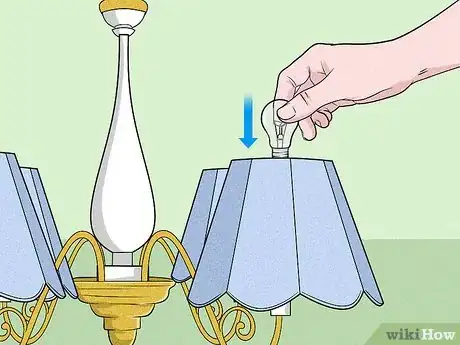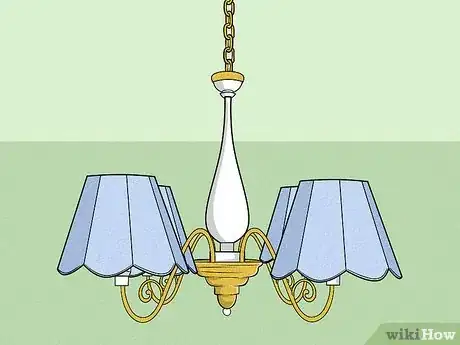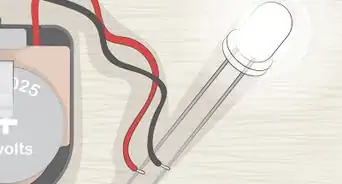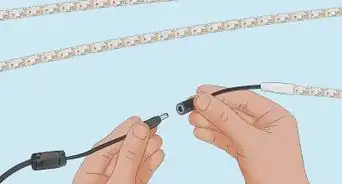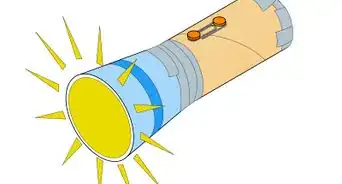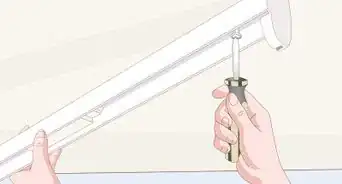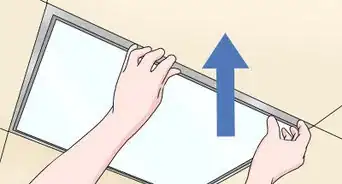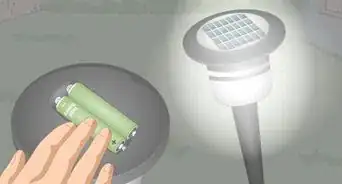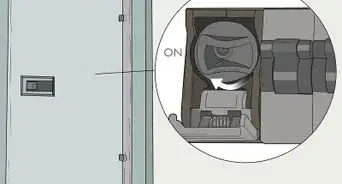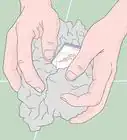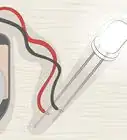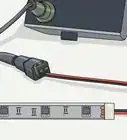This article was co-authored by Ryaan Tuttle. Ryaan Tuttle is a Home Improvement Specialist and the CEO of Best Handyman, Inc. in Boston, Massachusetts. With over 17 years of experience, he specializes in building home service businesses, focusing on creating scalable and efficient brands. With the help of his global team, the companies have achieved over 10+ million in sales and received recognition through magazine features, and enjoy partnerships with wikiHow and Jobber field service software. Boston Magazine and LocalBest.com have named Best Handyman Boston the Best Handyman in Boston. Ryaan holds Construction Supervisor and Home Improvement Contractor Licenses.
There are 7 references cited in this article, which can be found at the bottom of the page.
This article has been viewed 319,246 times.
Chandeliers are an attractive lighting option, and basic installation using a strong, existing ceiling support should take an hour or so. Be sure to take the extra time to install an appropriate support as described below if your chandelier is heavier that your previous light fixture. An assistant is recommended to make this process faster and easier.
Steps
Removing an Old Fixture
-
1Turn off the power. Switch off the power to the circuit where the chandelier will be located or unscrew the fuse for the fixture you are replacing. If the circuits are unlabeled, you may have to test them with trial and error until the current fixture turns off.
- If you don't know where your electric panel is, see How to Find the Fuse Box or Circuit Breaker Box.
- Consider taping a note to the circuit box to let other people in the house know that you'll be working with electrical wiring and that the circuit should not be turned back on.
-
2Verify that the power is off. Turn the light switch on and off a few times to make sure there is no power running to the current fixture. If there is no fixture currently installed in that location, use a non-contact voltage tester or circuit tester to test each wire. You may use a multimeter instead, although the device is more complicated to use.
- Follow instructions carefully when using a multimeter to test for voltage. Using the wrong settings could give you a false reading or damage the device.
Advertisement -
3Remove detachable portions from the old fixture. If a fixture is currently installed that includes light bulbs, glass light covers, or other detachable parts, remove them now and set them aside. This makes it easier to detach the fixture without breaking these pieces.
- You may skip this step if the fixture is small and you have an assistant to help you remove it.
-
4Detach the old fixture. You may require a screwdriver or wrench to remove any screws or lock nuts attaching the fixture to the ceiling. Make sure you or an assistant has a firm grip on the fixture before you detach it from the ceiling. Do not detach the wires yet.
- This step may be much easier with an assistant to hold the fixture. A stepladder may also be required.
- Do not let the old fixture hang with no support other than the wiring. This will likely cause the fixture to fall and could damage the wiring as well.
-
5Note how the wires are connected. There should be two or more wires connecting your old fixture to your home electrical system. They may be color coded with white and black insulation, or identified with a ridge or lettering. While full wiring instructions will be given later on in these instructions, you may have an easier time if you make a diagram of where each wire is connected. If the wires are not easily distinguished from each other, mark them with colored tape.
-
6Disconnect the wiring. Unscrew the plastic wire connectors counterclockwise and detach wires. Transfer the old fixture to a storage space where it won't get in the way of the installation.
Installing Support for your Chandelier
-
1Turn off the power. If you did not need to remove an old fixture as described earlier, you may not have turned off the power. Go to the electrical panel and turn off the circuit breaker or remove the fuse associated with the circuit you'll be working on. Make sure the power is off by using a circuit tester or by removing power to the entire house.
-
2Confirm if your new chandelier can safely hang from the mounting box. Check the rating of your original chandelier's mounting box. Then, confirm if that mounting box will support your other chandelier.[1]
- If the current support is sufficient to hold your chandelier, you may skip to the next section.
- For reference, typical ceiling mounting boxes are intended to support no more than 50 pounds (22.7kg).[2]
-
3Remove the existing mounting box. This plastic or metal box should be attached to the ceiling or a brace bar using screws or nails. Remove these with a screwdriver or hammer, and pry the box away from the ceiling.[3]
- These are also referred to as junction boxes or electrical boxes.
-
4Saw apart the existing brace bar. If there is a metal bar resting on top of the ceiling, use a close quarter hacksaw to cut it in half.[4] Pull the two pieces through the hole and discard them.
-
5If the fixture is between ceiling joists, use a fan brace. Purchase a fan brace rated to support a higher weight than your chandelier's; most can support a weight up to 150 pounds (68 kg). Put the fan brace through the hole in the ceiling and rotate it so it is resting on top of the ceiling, across the hole. Turn the bar between your fingers to extend its arms until you feel both ends make contact with the ceiling joists. Use a wrench to tighten the brace firmly, but do not put tension on the joists by using excessive force.[5] [6] The spiked ends should dig into the wooden joists, and the rectangular bar should end up with sides parallel to the ceiling.
- Place the bracket that came with your fan brace over the top of the brace, with bolts placed through its holes. Slot the mounting box onto the bolts and attach by fastening the nuts.[7]
-
6If the fixture is under a ceiling joist, use a pancake style box. Heavy-duty junction boxes are round metal objects sometimes referred to as "pancake boxes". Make sure to choose one that is able to support the chandelier's weight. Mount it to the ceiling joist using only the high weight capacity screws that came with the box. Do not try to use standard screws, or the chandelier could break free of the ceiling.[8]
- Make sure the wires are slotted through the hole in the side of the box before you attach it. They should be easily reachable once the box is installed.
Attaching the Chandelier
-
1Assemble the chandelier base. Screw all parts of the chandelier together, except for the canopy that will be attached to the ceiling. Don't install the light bulbs yet as it will be easier and safer to mount the chandelier without them.
-
2Shorten the chain if necessary. Your chandelier may have more chain than you need. Decide how long a chain you'd like, then use a pair of heavy pliers to open one of the chain's links at the chosen point and remove the excess length.[9]
- The base of light fixtures should be at least 30 inches (76 cm) above table surfaces to reduce the chance of bumping into them and to provide good illumination.[10]
- Chandeliers hanging in foyers and other locations used by large numbers of people should be at least seven feet above the floor, and out of the way of tall doors.
-
3Install a mounting strip to your mounting box. This small metal bar with holes in it should come with your chandelier, or there may be one already installed. They are also available at hardware stores.[11]
- To install a mounting strip, simply screw it into the junction box at the existing screw holes, the placements of which vary with junction box design. Be sure to use screws of suitable size to make a tight connection.
-
4Thread the chandelier wires through each section of the chandelier. Thread all of the chandelier's wires through every other chain link. Continue to thread them through the metal canopy the will cover the electrical box, the small chain holder that attaches to the top of the chain, and finally the thin metal nipple which holds the wires together. They should extend fully through the nipple, far enough for you to work with them easily.
-
5Mount the chandelier. In order to attach each of the wires, you will need to have the chandelier stable in place near the ceiling. Either have a strong assistant hold the chandelier in place, or hang the chain or chain holder from a strong hook hanging from the mounting strip.
-
6Wrap each bare copper wire around the grounding screw. Both the chandelier and your home electrical system should have a bare copper grounding wire. Each of these should be wrapped around the grounding screw attached to your junction box, making sure the two wires are in contact with each other.[12] This screw is often colored green.
- The grounding wires send excess current to the ground (or another safe location) in case of fault.
-
7Strip the ends of the chandelier's insulated wires. Use a wire stripper to remove about 0.5 inches (1.25 cm) of each wire's insulation, so the bare wire is exposed.
-
8Join the neutral wires together. The neutral wires carry current to the ground in normal use. Find the chandelier wire that has an identifying mark such as a groove, ridge, or lettering. Place the bare end of this wire together with the end of the white-insulated wire coming through the junction box, and twist together with a wire connector.
- You may choose to splice the wires yourself and cover the connection thoroughly with electrical tape instead.
- If the ceiling wires do not have white insulation, you may need to refer to the diagram of your old light fixture you made in an earlier section and determine which wire of your old light fixture was neutral (with an identifying mark as described above).
-
9Join the hot wires together. These are the wires that carry current to the chandelier. The black insulated ceiling wire should be joined with the insulated chandelier wire with no identifying marks should be connected the same way. Twist the bare ends together with a plastic wire connector.
- If there are more wires than mentioned here, or the number of wires in the chandelier and junction box do not match up, you may need to call an electrician to safely install your system.
-
10Bolt the chandelier into place. After mounting and wiring the chandelier, screw in the bolts or lock nuts to secure it to the ceiling. This process may vary according to your chandelier model, so you may need to read the instructions to locate the attachment points.
-
11Test the chandelier. Install the bulbs, switch on the power and test the chandelier. If it does not come on, you may have connected the wrong wires. Be sure to switch off the power before attempting to switch the wire connections. Call an electrician if you cannot get the chandelier to work yourself.
-
12Finished.
Expert Q&A
-
QuestionHow do I know if my mounting box will hold my chandelier?
 Ryaan TuttleRyaan Tuttle is a Home Improvement Specialist and the CEO of Best Handyman, Inc. in Boston, Massachusetts. With over 17 years of experience, he specializes in building home service businesses, focusing on creating scalable and efficient brands. With the help of his global team, the companies have achieved over 10+ million in sales and received recognition through magazine features, and enjoy partnerships with wikiHow and Jobber field service software. Boston Magazine and LocalBest.com have named Best Handyman Boston the Best Handyman in Boston. Ryaan holds Construction Supervisor and Home Improvement Contractor Licenses.
Ryaan TuttleRyaan Tuttle is a Home Improvement Specialist and the CEO of Best Handyman, Inc. in Boston, Massachusetts. With over 17 years of experience, he specializes in building home service businesses, focusing on creating scalable and efficient brands. With the help of his global team, the companies have achieved over 10+ million in sales and received recognition through magazine features, and enjoy partnerships with wikiHow and Jobber field service software. Boston Magazine and LocalBest.com have named Best Handyman Boston the Best Handyman in Boston. Ryaan holds Construction Supervisor and Home Improvement Contractor Licenses.
Home Improvement Specialist Take the original chandelier and see what size the mounting box is. Then, check and see if that mounting box is rated for your other chandelier.
Take the original chandelier and see what size the mounting box is. Then, check and see if that mounting box is rated for your other chandelier. -
QuestionMy handyman just installed my chandelier, but the canopy and light portion is just hanging by the wires, and the chain is not linked. Am I asking for trouble or is this going to be okay?
 Community AnswerThe chandelier should never hang by the wires. Call your handyman back to install it correctly, and do not pay him until the job is done correctly.
Community AnswerThe chandelier should never hang by the wires. Call your handyman back to install it correctly, and do not pay him until the job is done correctly. -
QuestionI'm installing a new chandelier, it has 3 wires, the ceiling has 4 wires, 1 bare, which I know is the ground, a black, red, and white. Which wires do I use from the ceiling?
 Community AnswerYou have to measure the resistance between the red, black, and white. If the maximum resistance is found between red and white, then the black wire is the common. One of the three wires is common and it should be connected to the neutral. The other two wires should be connected to double pole switches.
Community AnswerYou have to measure the resistance between the red, black, and white. If the maximum resistance is found between red and white, then the black wire is the common. One of the three wires is common and it should be connected to the neutral. The other two wires should be connected to double pole switches.
Warnings
- The capability of a person to hold the chandelier depends on its weight. Don't entrust a weak or frail person to lift up the chandelier.⧼thumbs_response⧽
- Do not mount the chandelier directly into place. Lift it up, connect the wires and then mount it into place.⧼thumbs_response⧽
- The installation of chandeliers varies from model to model. Read the installation guide before installing a chandelier.⧼thumbs_response⧽
Things You'll Need
You may not need every tool for your job. Read the instructions to find out which tools are suitable for your installation project.
- Screwdriver
- Wrench
- Pliers (with rubber-coated handles)
- Colored tape (or masking tape & pen for labeling)
- Wire connectors
- Wire stripper
- Fan brace or heavy-duty electrical box
- Mounting strap
- Stepladder
- Assistant (recommended)
References
- ↑ Ryaan Tuttle. Home Improvement Specialist. Expert Interview. 14 May 2021.
- ↑ http://www.popularmechanics.com/home/improvement/interior/how-to-install-a-stylish-chandelier-15087619
- ↑ http://www.thisoldhouse.com/toh/how-to/step/0,,767799_764797,00.html
- ↑ http://www.thisoldhouse.com/toh/how-to/step/0,,767799_764797,00.html
- ↑ http://www.thisoldhouse.com/toh/how-to/step/0,,767799_764802,00.html
- ↑ http://www.popularmechanics.com/home/improvement/interior/how-to-install-a-stylish-chandelier-15087619
- ↑ http://www.ronhazelton.com/projects/how_to_put_up_a_chandelier
- ↑ http://www.popularmechanics.com/home/improvement/interior/how-to-install-a-stylish-chandelier-15087619
- ↑ http://www.hammerzone.com/archives/elect/fixture/lighting/chandelier/install.htm
About This Article
To install a chandelier, start by turning off the power and removing the old fixture. Be sure to disconnect the wiring from the old fixture and leave the wires hanging from the ceiling. Next, assemble the chandelier but don't install the light bulbs yet, since it's safer to mount the chandelier without them. Thread the chandelier wires through the chandelier and mount the chandelier. Then, strip the ends of the chandelier's wires before joining the neutral wires together, then the hot wires together. Finally, bolt your new chandelier into place! For more tips on disconnecting and removing an old fixture, read on!
